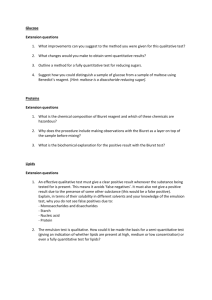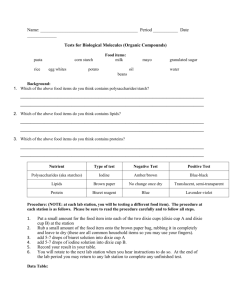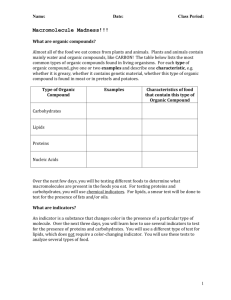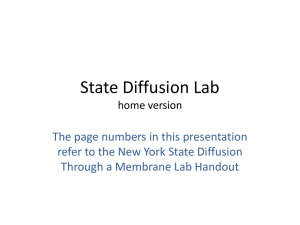Laboratory 4 Biomolecules found in foods
advertisement
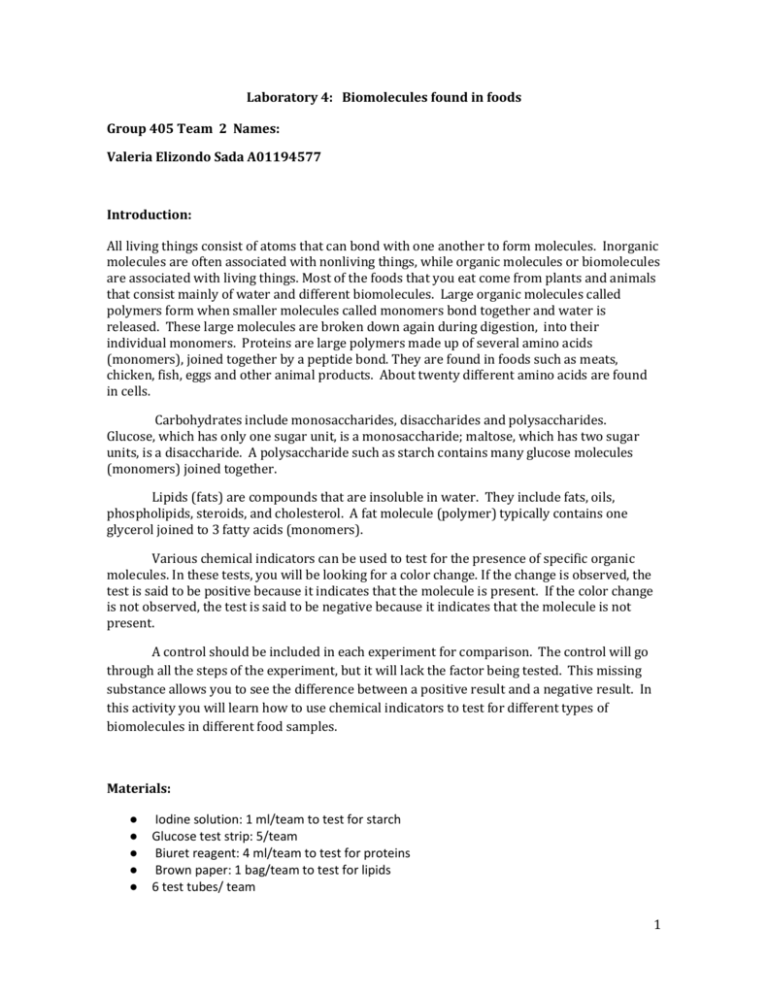
Laboratory 4: Biomolecules found in foods Group 405 Team 2 Names: Valeria Elizondo Sada A01194577 Introduction: All living things consist of atoms that can bond with one another to form molecules. Inorganic molecules are often associated with nonliving things, while organic molecules or biomolecules are associated with living things. Most of the foods that you eat come from plants and animals that consist mainly of water and different biomolecules. Large organic molecules called polymers form when smaller molecules called monomers bond together and water is released. These large molecules are broken down again during digestion, into their individual monomers. Proteins are large polymers made up of several amino acids (monomers), joined together by a peptide bond. They are found in foods such as meats, chicken, fish, eggs and other animal products. About twenty different amino acids are found in cells. Carbohydrates include monosaccharides, disaccharides and polysaccharides. Glucose, which has only one sugar unit, is a monosaccharide; maltose, which has two sugar units, is a disaccharide. A polysaccharide such as starch contains many glucose molecules (monomers) joined together. Lipids (fats) are compounds that are insoluble in water. They include fats, oils, phospholipids, steroids, and cholesterol. A fat molecule (polymer) typically contains one glycerol joined to 3 fatty acids (monomers). Various chemical indicators can be used to test for the presence of specific organic molecules. In these tests, you will be looking for a color change. If the change is observed, the test is said to be positive because it indicates that the molecule is present. If the color change is not observed, the test is said to be negative because it indicates that the molecule is not present. A control should be included in each experiment for comparison. The control will go through all the steps of the experiment, but it will lack the factor being tested. This missing substance allows you to see the difference between a positive result and a negative result. In this activity you will learn how to use chemical indicators to test for different types of biomolecules in different food samples. Materials: ● ● ● ● ● Iodine solution: 1 ml/team to test for starch Glucose test strip: 5/team Biuret reagent: 4 ml/team to test for proteins Brown paper: 1 bag/team to test for lipids 6 test tubes/ team 1 ● Food samples: egg white, starch suspension 10%, corn oil, sugar solution 50%, water and an unknown food sample ● Masking tape ● Pencil or crayon ● Copy of the activity 1. Predict whether each substance is an organic compound and if so, what type. Substance Vegetable oil Glucose solution Starch solution Egg whites Water Do you think this substance is a carbohydrate, lipid, protein, or none of these? Lipids Carbohydrate Lipids Lipids None 2. Testing for lipids a) If a food that contains lipids is put on brown paper, it will leave a spot that lets light through. To test for lipids, divide a piece of a brown paper bag into 5 sections. Label the sections "vegetable oil", "glucose", "starch", "egg whites", and “water”. b) In each section, rub a small amount of the substance onto the brown paper. c) With a paper towel, rub off any excess that may stick to the paper. Set the paper aside until the spots appear dry—about 10 to 15 minutes. d) Which substances do you expect to test positive for lipids? Vegetable oil, egg whites, starch. e) Which substances do you expect to test negative for lipids? Water, glucose. f) Continue on with the rest of the tests. After all the sections of the brown paper are dry, hold it up to a bright light or window. You will notice that at least one sample has left a spot that lets light through on the brown paper. The spot indicates the presence of lipids. g) Complete the last column of the data table below. Put a plus for any samples which tested positive for lipids and a minus for the samples which tested negative. Sample Vegetable oil Glucose solution 50% Carbohy drate Tests Protein Test Test strip color Glucose present - - - - Iodine test color Transparent orange Transparent orange Starch presen t Lipid Test Biuret test color Blue no Blue no Protein present Lipid present + 2 Starch solution 10% Yellow Egg whites Water Milk Blue No Black Starch Blue no - - White Yellow Yes - - Transparent orange Blue no Blue no Yes + + Testing for Carbohydrates a) You will use an indicator to test for starch. Obtain 5 test tubes and use masking tape to make labels for each one. Label the containers "vegetable oil", "glucose", "starch", "egg whites", and “water”. b) For each container, add a small amount of the substance indicated on the maskingtape label. Now add about 2 ml of water to each container. Stir the contents of each container to mix the sample and water. c) To test for starch you will use iodine as an indicator. In the presence of starch, iodine will change color from yellow-brown to blue-black. Add 5 drops of iodine solution to each container. Stir the contents of each container. d) In the data table, record the color of the iodine solutions. Put a plus next to those samples testing positive for starch and a minus for those testing negative. e) To test for glucose you will use a test strip with an indicator pad that changes color in the presence of glucose. Prepare a piece of paper with the name of each substance and a place to put the glucose test strip used to test that substance. Dip one test strip into each sample for 1-2 seconds. Remove the strip, put it in the appropriate spot on your labeled paper, and wait 3 minutes. f) After 3 minutes, record the color for each glucose test strip in the data table. Put a plus next to those samples testing positive for glucose and a minus for those testing negative. 3. Testing for Proteins a) Label five clean test tubes "vegetable oil", "glucose", "starch", "egg whites", and “water”. Add a small amount of the substance indicated on the label to each container. Add about 2 ml of water to each container. Stir the contents of each container to mix the food and water. b) To test for protein you will use Biuret reagent as an indicator. Biuret reagent turns from blue to purple in the presence of protein. Add 20 drops of biuret reagent to each container. Stir the contents of each container. c) Record the color of each Biuret solution in the data table. Put a plus next to those samples testing positive for protein and a minus for those testing negative. d) Rinse all test tubes thoroughly. Questions 1. Compare your predictions with your test results. Were there any differences between your test results and your predictions for what type of organic compound each test substance is? Yes, the egg whites does not have lipids and we thought it had,egg white has proteins. We thought the glucose would have carbohydrates but it doesn't have. 3 2. Did your test for glucose indicate there was glucose in the starch sample? mean that there is no glucose in starch? My test indicates theres isn’t glucose in the starch and no. Does that 3. Suppose that for the container containing water you found a positive test for one of the organic compounds. How would you interpret this result? If the test came positive, I will get the conclusion that the water have lipids, protein and carbohydrate. I would think that water is not natural and pure it makes us fat. 4



